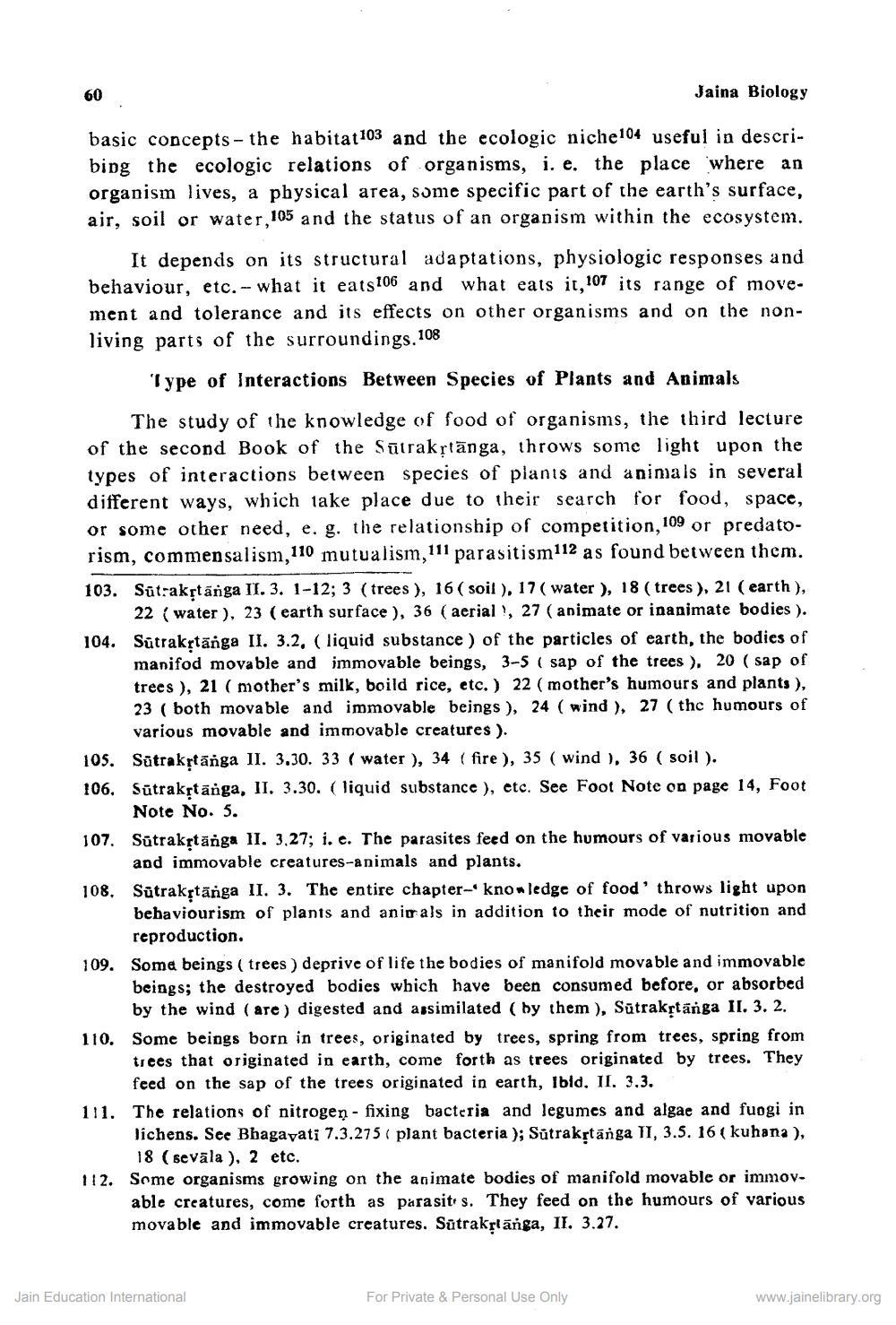________________
60
Jaina Biology
basic concepts - the habitat 103 and the ecologic niche104 useful in describing the ecologic relations of organisms, i. e. the place where an organism lives, a physical area, some specific part of the earth's surface, air, soil or water, 105 and the status of an organism within the ecosystem.
It depends on its structural adaptations, physiologic responses and behaviour, etc. -- what it eats 106 and what eats it, 107 its range of movement and tolerance and its effects on other organisms and on the nonliving parts of the surroundings. 108
Type of Interactions Between Species of Plants and Animals
The study of the knowledge of food of organisms, the third lecture of the second Book of the Sūtrakrtānga, throws some light upon the types of interactions between species of plants and animals in several different ways, which take place due to their search for food, space, or some other need, e. g. the relationship of competition, 109 or predatorism, commensalism, 110 mutualism, 111 parasitism 112 as found between them. 103. Sūtrakstānga II. 3. 1-12; 3 (trees ), 16 ( soil), 17 ( water ), 18 (trees ), 21 (earth),
22 (water), 23 ( earth surface ), 36 (aerial !, 27 ( animate or inanimate bodies ). 104. Sūtrakrtānga II. 3.2. (liquid substance ) of the particles of earth, the bodies of
manifod movable and immovable beings, 3-5 ( sap of the trees ), 20 ( sap of trecs ), 21 ( mother's milk, boild rice, etc.) 22 (mother's humours and plants ), 23 ( both movable and immovable beings ), 24 (wind ), 27 ( thc humours of
various movable and immovable creatures ). 105. Sūtrakstānga II. 3,30. 33 (water), 34 (fire), 35 ( wind ), 36 ( soil ). 106. Sūtrakstānga, II. 3.30. (liquid substance ), etc. See Foot Note on page 14, Foot
Note No. 5. 107. Sūtrakstānga 11. 3.27; i. e. The parasites feed on the humours of various movable
and immovable creatures--animals and plants. 108. Sūtrakştānga II. 3. The entire chapter-knowledge of food' throws light upon
behaviourism of plants and animals in addition to their mode of nutrition and
reproduction. 109. Some beings ( trees) deprive of life the bodies of manifold movable and immovable
beings; the destroyed bodies which have been consumed before, or absorbed
by the wind (are) digested and assimilated ( by them ), Sūtrakstānga II. 3. 2. 110. Some beings born in trees, originated by trees, spring from trees, spring from
trees that originated in earth, come forth as trees originated by trees. They
feed on the sap of the trees originated in earth, Ibid. II. 3.3. 111. The relations of nitrogen - fixing bacteria and legumes and algae and fuogi in
Jichens. See Bhagavati 7.3.275( plant bacteria ); Sutrakstānga II, 3.5. 16 ( kuhana ),
18 (sevāla ), 2 etc. 112. Some organisms growing on the animate bodies of manifold movable or immov
able creatures, come forth as parasits. They feed on the humours of various movable and immovable creatures. Sūtrakrlänga, II. 3.27.
Jain Education International
For Private & Personal Use Only
www.jainelibrary.org




